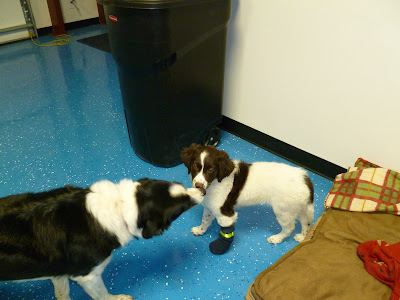Well, I had planned to detail the riveting process in this post. But, I was working by myself during this phase and I had no one but Roxy to take any pictures. And her photos always have an avant-garde quality about them that takes certain liberties with photographic composition.
All of the rivets attaching the skin, except those around the edges, are bucked using the rivet gun and bucking bar. One arm goes inside the VS holding the bar and the other arm holds the gun. A third arm at this point would be useful to place the next rivet.
The process of bucking a rivet is pretty easy. Put the rivet in the hole and smash one end with a rivet gun while other end is held immobile against a bucking bar. The rivet gun is simply a pneumatic hammer and the bucking bar a heavy piece steel, or in my favorite example, a piece of tungsten.
For the rivets around the periphery of the VS, the pneumatic squeezer will reach and this is my preferred rivet treatment as it is probably 4 times faster than bucking.
 Carolina applies the finishing three pull rivets to the middle rib that can not be reached with solid rivets once the rear spar is in place.
Carolina applies the finishing three pull rivets to the middle rib that can not be reached with solid rivets once the rear spar is in place.
So the vertical stabilizer is done for now and is safely stored out of the way. The next step will be the rudder.
 |
| Roxy and Trina discuss a technical matter. |


No comments:
Post a Comment